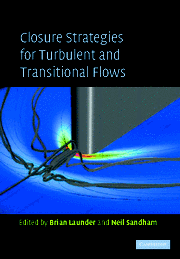26 - Recent Developments in Two-Point Closures
Published online by Cambridge University Press: 06 July 2010
Summary
Abstract
Extensions of the frontiers of rapid distortion theory (RDT) and multi-point closures are discussed, especially developments leading towards inhomogeneous turbulence. Recent works related to zonal RDT and stability analyses for wavepacket disturbances to non-parallel rotational base flows are presented. Application of linear theories to compressible flows are touched upon. Homogeneous turbulence is revisited in the presence of dispersive waves, taking advantage of the close relationship between recent theories of weakly nonlinear interactions, or ‘wave-turbulence’, and classical two-point closure theories. Among various approaches to multi-point description and modelling, a review is given of multi-scale or multi-tensor transport models, which use, more or less explicitly, a spectral formulation.
Inhomogeneous turbulence
Multi-point formulations are not nearly as well-developed for inhomogeneous as for homogeneous turbulence. An assumption of weak inhomogeneity, in which variations of the flow statistics take place over distances greater than O(ℓ), the size of the large turbulent eddies, allows some progress to be made, as, to a lesser extent, does the RDT limit of weak turbulence.
Linear theories
The solution of RDT with a known mean flow Ui, arbitrarily varying in space, is a difficult problem in general, but becomes somewhat simpler if the mean flow is irrotational, as in the classical case of high Reynolds number flow past a body, outside the wake and boundary layer. Consider a particle convected by the flow, having position x′ at time t′ and x at time t. The deformation of fluid elements is characterised by the Cauchy tensor and the evolution of vorticity for inviscid incompressible flow is then described by the Cauchy solution The above formulation is exact and expresses the classical theory of inviscid vortical dynamics. However, in the context of RDT for irrotational mean flows, one can neglect the fluctuating part of the velocity compared with the mean part, x and x′ are related by mean flow convection and Fij becomes the deformation tensor of the mean flow alone. Since the mean flow is assumed irrotational, there is no mean vorticity, and (2) describes the fluctuating vorticity giving the curl of the fluctuating velocity u′i.
Information
- Type
- Chapter
- Information
- Closure Strategies for Turbulent and Transitional Flows , pp. 740 - 754Publisher: Cambridge University PressPrint publication year: 2002
Accessibility standard: Unknown
Why this information is here
This section outlines the accessibility features of this content - including support for screen readers, full keyboard navigation and high-contrast display options. This may not be relevant for you.Accessibility Information
- 1
- Cited by
